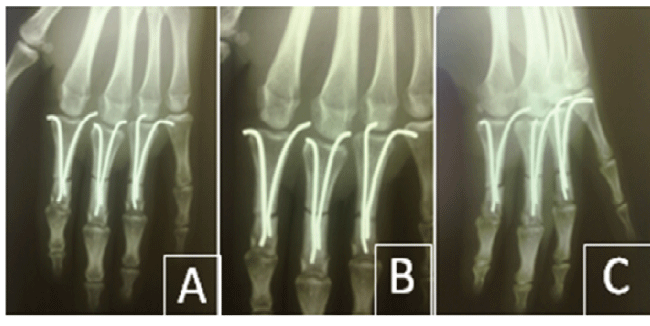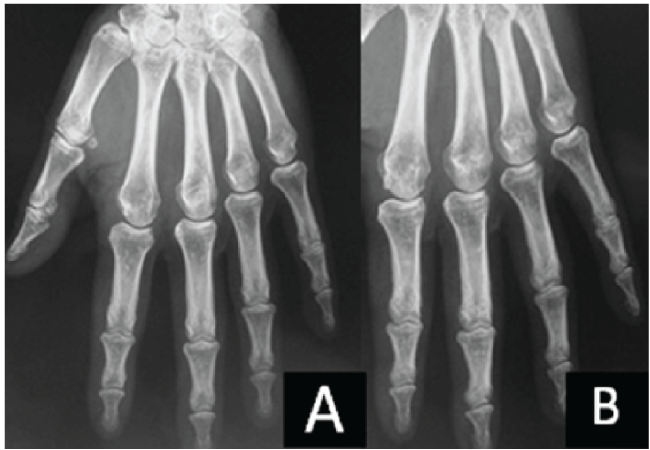Journal of Musculoskeletal Disorders and Treatment
Infrequently Encountered Multiple Displaced Proximal Phalangeal Fractures of the Hand: A Surgical Case Report
Hamdi Kaziz*, Thabet Mouelhi, Mohamed Amine Triki, Yamen Grissa, Nader Naouar and Mohamed Laziz Ben Ayeche
Orthopedics Traumatology Department, Sahloul University Hospital, Tunisia
*Corresponding author:
Hamdi Kaziz, Orthopedics Traumatology Department, Sahloul University Hospital, Tunisia, E-mail: hamdi.kaziz@yahoo.fr, hamdi.kaziz@gmail.com
J Musculoskelet Disord Treat,
JMDT-1-004, (Volume 1, Issue 1),
Case Report
Received: October 06, 2015: Accepted: November 14, 2015: Published: November 16, 2015
Citation: Kaziz H, Mouelhi T, Triki MA, Grissa Y, Naouar N, Ayeche MLB (2015) Infrequently Encountered Multiple Displaced Proximal Phalangeal Fractures of the Hand: A Surgical Case Report. J Musculoskelet Disord Treat 1:004
Copyright: © 2015 Kaziz H, et al. This is an open-access article distributed under the terms of the Creative Commons Attribution License, which permits unrestricted use, distribution and reproduction in any medium, provided the original author and source are credited.
Abstract
This case report describes a high energy injury to the hand that resulted in displaced transverse proximal phalangeal fractures of the 2nd, 3rd and 4th fingers. Although single phalangeal fractures are frequently seen in clinical settings, multiple displaced fractures are encountered infrequently. A 30 year old male was seen in our clinic who had sustained a worked related injury resulting in three transverse midshaft phalangeal fractures that were treated with closed reduction and percutaneous fixation, with two 0.10 mm k-wires retrograded through each fracture site. A one year follow-up revealed excellent fracture alignment, healing, range of motion and cosmetic result. This case illustrates how it is possible to obtain an excellent surgical result in multiple displaced phalangeal fractures with Kirschner wires that are inexpensive and have been available to surgeons for decades.
Keywords
K-Wire fixation, Phalangeal fracture, Displaced fracture, Multiple fractures, Outcomes
Introduction
Proximal phalangeal fractures are frequently seen in hand injuries. However, multiple proximal phalangeal fractures are uncommon and they are the direct result of a high energy force. The prevalence of multiple phalangeal fractures in our hospital is estimated at roughly 3 cases each year but rarely multiple displaced fractures have been reported. The treatment depends on whether they are displaced, comminuted, compound, intraarticular, spiral, or avulsion injuries. Simple minimally displaced fractures are more likely to be treated non-operatively by external reduction and immobilization whereas; unstable fractures with a high risk of shortening, displacement, angulation and rotational deformity require reduction and surgical stabilization. Several options have been reported to treat these injuries such as plates, intramedullary screws, absorbable pins and Kirschner wire fixation. The objective of surgical treatment is to insure stability of the fracture with fixation and allow early mobilization of the fingers to achieve functional recovery as early as possible. The aim of our case report is to remind orthopedic surgeons of the simple operative option of intramedullary fixation with kirschner wires of the phalanges to establish stable fixation of the fracture site, while minimizing the potential for rotational displacement and allowing for early mobilization.
Case Report
We report on a 30 year-old male, Tunisian young man, without medical issues, referred to our department after a work accident with an entrapment of his left hand in a press paper machine. Physical examination revealed a deformity of the second, third and fourth digits which were malaligned, ecchymotic with a total swelling of his hand. No open wounds were observed. Radiographs showed angulated displaced mid shaft fractures of the second, third and fourth proximal phalanges (Figure 1). Under general anesthesia and fluoroscopy, a closed reduction was performed on each digit, with the fractures fixated with two intramedullary 0.20 K-wires retrograded through each phalangeal base and advanced distally to the head of the phalangeal bone. The procedure encompassed the introduction of two curved K-wires (diameter: 0.20) through the phalangeal base after a first opening of the medullary canal with another incurved K-wire, then the curved K-wire were advanced distally under fluoroscopy. The same procedure was repeated for the two others phalanges (Figure 2).

.
Figure 1: X-ray view of the left hand: an angulated mid-shaft fractures of the second, third and fourth proximal phalangeal bones.
View Figure 1

.
Figures 2: Postoperatively X-ray views: intramedullary nailing of the three proximal phalangeral fractures.
View Figures 2
Post operatively, the metacarpophalangeal and interphalangeal joints of each concerned finger were immobilized together with a plaster splint from the forearm to the distal interphalangeal joints, for 3 weeks to avoid stiffness. Radiological fracture union was seen at 4 weeks postoperatively. The K-wires were removed after 6 weeks postoperatively (Figure 3). After a six of physiotherapy consisting in early mobilization of fingers with first passive mobilization for 3 weeks than active one to increase the range of motion in these fingers. The patient regained 260° of total active range of motion (TAM). There were no complications. The patient had an uneventful recovery. Only the scars of the sites of K-wire introduction were so obvious (Figure 4). At a 12 month follow-up, the patient was pain free, with no evidence of residual post fracture sequelae and has returned to his previous work at the third month postoperatively.

.
Figure 3: Functional outcome at 1 year post operatively, total active motion of the fingers is at normal value 260°.
View Figure 3
Discussion
Stabilization of the metacarpal bones using K-wire fixation was first described by Foucher G [1] whereas intramedullary nailing of other bones has been described for more than five decades [2]. Furthermore, the same option was used for proximal phalangeal fractures of the hand by Hwa et al. and Gonzalez et al. [3,4]. This procedure is relatively simple and in general, carries less risk of infection than an open approach with plating. Although k-wire fixation does not provide as much rigidity, it does allow for early mobilization, physiotherapy and functional recovery [5]. Surgical options of treatment of phalangeal fractures can be discussed controversially. In fact, the majority of proximal phalangeal fractures of the hand can be treated successfully by non-operative treatment; unstable fractures with a high risk of displacement usually need operative fixation and stabilization [6]. Besides, biomechanical studies revealed that shortening of more than 3 mm and angulations exceeding 15° lead to a decrease of the flexion and extension of the finger [7,8]. The criteria for acceptable reduction in proximal phalangeal fractures have been described as an apposition of the fracture of more than 50%, no rotational deformity, less than 15° angulation of fracture fragments in the antero-posterior (AP) plane and 10° in the medial lateral plane [9]. Some surgical options have been reported and include the use of various devices for fixation: ORIF (open reduction internal fixation) with plates and screws, percutaneous pinning, crossed K-wires and external fixations. In spite of the more rigid fixation that a plate provides, there are significant drawbacks, including periosteal stripping, flexor adhesions and adherence and a higher risk for infection, including osteomyelitis [10-14]. In addition, ORIF is more expensive compared to other options [14]. Intramedullary fracture fixation with a single K-wire does not provide enough rotational stability to many fractures that are at risk [15]. Moreover, Using the cross K-wire fixation technique to stabilize unstable fractures can result in fracture distraction that carries a higher risk for delayed or non-union [16], damage of the extensor tendon may occur. Further, keeping the K-wire ends outside of the skin may lead to serious complications including soft tissue and osseous infections [17-19]. The concept of intramedullary nailing of phalangeal fractures of the hand is similar to intramedullary K-wire fixation of metacarpal neck fractures which has a long history of success and an important advantage of this technique in displaced or unstable proximal phalangeal fractures. The advantages are the preservation of soft tissue, including the extensor and flexor tendons [20]. The important advantage of this technique is the preservation of the soft tissue and most importantly the extensor tendons. It is important to not introduce the pins in either metacarpophalangeal or proximal interphalangeal joints to minimize loss of motion and increase the risk of scarring. We also recommend burying the ends of the wires to minimize the risk of sepsis.
Conclusion
Phalangeal fractures are typically treated non-operatively; however surgery is indicated in unstable or displaced fractures. The case study presented here illustrates how it is possible to obtain excellent results in multiple displaced proximal phalangeal fractures in one hand, with proper fluoroscopy guided and correctly positioned kirschner wires. In addition to the excellent results, this method has a history of success and is very cost effective.
References
-
Foucher G (1995) "Bouquet" osteosynthesis in metacarpal neck fractures: a series of 66 patients. J Hand Surg Am 20: S86-90.
-
Pankovich AM, Goldflies ML, Pearson RL (1979) Closed Ender nailing of femoral-shaft fractures. J Bone Joint Surg Am 61: 222-232.
-
Liew KH, Chan BK, Low CO (2000) Metacarpal and proximal phalangeal fractures--fixation with multiple intramedullary Kirschner wires. Hand Surg 5: 125-130.
-
Gonzalez MH, Igram CM, Hall RF (1995) Intramedullary nailing of proximal phalangeal fractures. J Hand Surg Am 20: 808-812.
-
Hall RF Jr (1987) Treatment of metacarpal and phalangeal fractures in noncompliant patients. Clin Orthop Relat Res: 31-36.
-
Vannet NB, Kempshall PJ, Davies JP (2009) Dorsally angulated proximal phalanx fractures : Closed reduction and rigid fixation using a reversed extension splint. Acta Orthop Belg 75: 405-407.
-
Low CK, Wong HC, Low YP, Wong HP (1995) A cadaver study of the effects of dorsal angulation and shortening of the metacarpal shaft on the extension and flexion force ratios of the index and little fingers. J Hand Surg Br 20: 609-613.
-
Manueddu CA, Della Santa D (1996) Fasciculated intramedullary pinning of metacarpal fractures. J Hand Surg Br 21: 230-236.
-
Gonzalez MH, Hall RF Jr (1996) Intramedullary fixation of metacarpal and proximal phalangeal fractures of the hand. Clin Orthop Relat Res: 47-54.
-
Ford DJ, el-Hadidi S, Lunn PG, Burke FD (1987) Fractures of the phalanges: results of internal fixation using 1.5mm and 2mm A. O. screws. J Hand Surg Br 12: 28-33.
-
Hastings H 2nd (1987) Unstable metacarpal and phalangeal fracture treatment with screws and plates. Clin Orthop Relat Res: 37-52.
-
Page SM, Stern PJ (1998) Complications and range of motion following plate fixation of metacarpal and phalangeal fractures. J Hand Surg Am 23: 827-832.
-
Pun WK, Chow SP, So YC, Luk KD, Ngai WK, et al. (1991) Unstable phalangeal fractures: treatment by A.O. screw and plate fixation. J Hand Surg Am 16: 113-117.
-
Stern PJ, Wieser MJ, Reilly DG (1987) Complications of plate fixation in the hand skeleton. Clin Orthop Relat Res: 59-65.
-
Vom saal FH (1953) Intramedullary fixation in fractures of the hand and fingers. J Bone Joint Surg Am 35A: 5-16.
-
Ikuta Y, Tsuge K (1974) Micro-bolts and micro-screws for fixation of small bones in the hand. Hand 6: 261-265.
-
Clifford RH (1953) Intramedullary wire fixation of hand fractures. Plast Reconstr Surg (1946) 11: 366-371.
-
Peacock EE (1953) Management of conditions of the hand requiring immobilization. Surg Clin North Am.
-
Green DP, Anderson JR (1973) Closed reduction and percutaneous pin fixation of fractured phalanges. J Bone Joint Surg Am 55: 1651-1654.
-
Ender, Weidner S (1970) The fixtierung the trochanteren briiche with round elastic condylenil glen. Acta Chirurgica Austriaca 40: 40-42.






